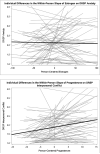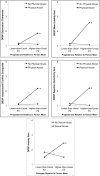Histories of abuse predict stronger within-person covariation of ovarian steroids and mood symptoms in women with menstrually related mood disorder
- PMID: 26896670
- PMCID: PMC4811338
- DOI: 10.1016/j.psyneuen.2016.01.026
Histories of abuse predict stronger within-person covariation of ovarian steroids and mood symptoms in women with menstrually related mood disorder
Abstract
Objective: Individual differences in sensitivity to cyclical changes in ovarian steroids estradiol (E2) and progesterone (P4) have been implicated in the pathophysiology of menstrually related mood disorder (MRMD). However, no prospective studies have investigated psychosocial risk factors for sensitivity to hormone effects on mood in MRMD. Using a repeated measures approach and multilevel models, we tested the hypothesis that a history of abuse provides a context in which within-person elevations of E2 and P4 prospectively predict daily symptoms.
Method: 66 women with prospectively-confirmed MRMD recruited for a trial of oral contraceptives provided 1 month of baseline hormone and mood data prior to randomization. Lifetime physical and sexual abuse experiences were assessed. Across one cycle, women completed daily measures of symptoms and provided blood samples on 5 days across the menstrual cycle. Current E2 and P4 were centered within person (CWP) such that higher values represented cyclical elevations in hormones.
Results: Rates of physical (27%) and sexual (29%) abuse were high, consistent with previous work documenting a link between trauma and MRMD. In women with a history of physical abuse, cyclical increases in P4 predicted greater mood and interpersonal symptoms on the three days following that sample. In women with a history of sexual abuse, cyclical increases in E2 predicted greater anxiety symptoms on the three days following that sample.
Conclusions: Results inform further inquiry into the role of severe life stressors and stress response systems in MRMD. We discuss areas for future research on the psychosocial and physiological pathways through which abuse may influence the link between hormones and symptoms.
Keywords: Abuse; Estradiol; Ovarian steroid hormones; Premenstrual dysphoric disorder; Progesterone.
Copyright © 2016 Elsevier Ltd. All rights reserved.
Figures


Similar articles
-
Differences in free estradiol and sex hormone-binding globulin in women with and without premenstrual dysphoric disorder.J Clin Endocrinol Metab. 2008 Jan;93(1):96-102. doi: 10.1210/jc.2007-1726. Epub 2007 Oct 23. J Clin Endocrinol Metab. 2008. PMID: 17956950 Free PMC article.
-
Menstrually related mood disorders and a history of abuse: moderators of pain sensitivity.Health Psychol. 2014 Feb;33(2):147-54. doi: 10.1037/a0031900. Epub 2013 Mar 25. Health Psychol. 2014. PMID: 23527515
-
The influence of early life sexual abuse on oxytocin concentrations and premenstrual symptomatology in women with a menstrually related mood disorder.Biol Psychol. 2015 Jul;109:1-9. doi: 10.1016/j.biopsycho.2015.04.003. Epub 2015 Apr 17. Biol Psychol. 2015. PMID: 25892085 Free PMC article.
-
Dimensional Affective Sensitivity to Hormones across the Menstrual Cycle (DASH-MC): A transdiagnostic framework for ovarian steroid influences on psychopathology.Mol Psychiatry. 2025 Jan;30(1):251-262. doi: 10.1038/s41380-024-02693-4. Epub 2024 Aug 15. Mol Psychiatry. 2025. PMID: 39143323 Review.
-
Premenstrual Mood Symptoms in the Perimenopause.Curr Psychiatry Rep. 2021 Oct 6;23(11):73. doi: 10.1007/s11920-021-01285-1. Curr Psychiatry Rep. 2021. PMID: 34613495 Review.
Cited by
-
Views of Dutch general practitioners about premenstrual symptoms: A qualitative interview study.Eur J Gen Pract. 2021 Dec;27(1):19-26. doi: 10.1080/13814788.2021.1889505. Eur J Gen Pract. 2021. PMID: 33729076 Free PMC article.
-
Attention-deficit/hyperactivity disorder and the menstrual cycle: Theory and evidence.Horm Behav. 2024 Feb;158:105466. doi: 10.1016/j.yhbeh.2023.105466. Epub 2023 Nov 30. Horm Behav. 2024. PMID: 38039899 Free PMC article. Review.
-
Perimenstrual exacerbation of symptoms in borderline personality disorder: evidence from multilevel models and the Carolina Premenstrual Assessment Scoring System.Psychol Med. 2018 Sep;48(12):2085-2095. doi: 10.1017/S0033291718001253. Epub 2018 May 28. Psychol Med. 2018. PMID: 29804553 Free PMC article.
-
Cyclical exacerbation of suicidal ideation in female outpatients: Prospective evidence from daily ratings in a transdiagnostic sample.J Psychopathol Clin Sci. 2023 Aug;132(6):704-715. doi: 10.1037/abn0000838. Epub 2023 Jun 15. J Psychopathol Clin Sci. 2023. PMID: 37326562 Free PMC article.
-
Clinical correlates of women endorsing premenstrual suicidal ideation: a cross-sectional study.Biopsychosoc Med. 2022 Nov 8;16(1):23. doi: 10.1186/s13030-022-00252-3. Biopsychosoc Med. 2022. PMID: 36348456 Free PMC article.
References
-
- Bandelow B, Krause J, Wedekind D, Broocks A, Hajak G, Rüther E. Early traumatic life events, parental attitudes, family history, and birth risk factors in patients with borderline personality disorder and healthy controls. Psychiatry Res. 2005;134(2):169–179. http://dx.doi.org/10.1016/j.psychres.2003.07.008. - DOI - PubMed
-
- Bartz JA, Zaki J, Bolger N, Ochsner KN. Social effects of oxytocin in humans: context and person matter. Trends Cognit. Sci. 2011;15(7):301–309. - PubMed
-
- Bertone-Johnson ER, Whitcomb BW, Missmer SA, Manson JE, Hankinson SE, Rich-Edwards JW. Early life emotional. physical, and sexual abuse and the development of premenstrual syndrome: a longitudinal study. J. Women's Health. 2014 http://dx.doi.org/10.1089/jwh.2013.4674,140806113637009. - DOI - PMC - PubMed
Publication types
MeSH terms
Substances
Grants and funding
LinkOut - more resources
Full Text Sources
Other Literature Sources
Medical

